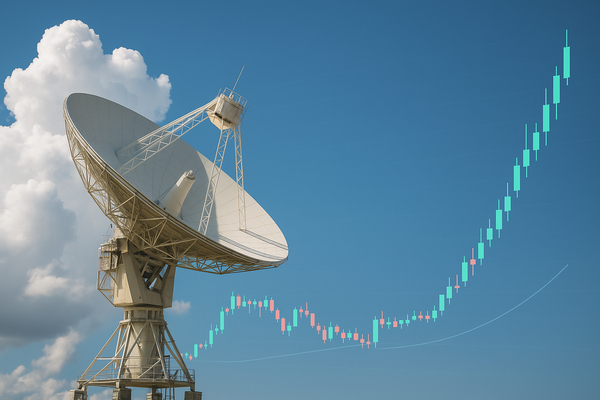
AST SpaceMobile’s stc Agreement Moves Stocks
AST SpaceMobile (ASTS) surged after a 10-year commercial deal with stc group, which includes a US$175 million prepayment and infrastructure commitments in Saudi Arabia and regional markets. The pact raises near-term revenue visibility for ASTS while offering a multi-year revenue stream tied to direct-to-device satellite connectivity. In the short term, the market reacted: ASTS shares climbed 8.9% on the announcement and have posted a 1-month gain of 40.9%, signaling heavy investor interest. Over the longer term, the partnership ties ASTS into large carrier networks across the Middle East and Africa, which could lift contract-backed revenue growth versus earlier, pilot-era milestones. Globally, the deal echoes recent telecom-satellite tie-ups that aim to extend coverage in underserved regions — a trend that matters to U.S., European and Asian investors as carriers seek redundancy and new ARPU sources. Locally, stc’s infrastructure build in Saudi Arabia adds capex and jobs, while the $175 million upfront payment accelerates ASTS’s near-term cash runway relative to prior financing cycles. This news matters now because it converts prospective pipeline into a decade-long commercial contract and a material prepayment that moved the stock sharply today.
AST SpaceMobile and the commercialization of direct-to-device satellite services
AST SpaceMobile’s agreement with stc links a technology story to explicit revenue mechanics. The 10-year contract includes a US$175 million prepayment for future services and infrastructure commitments in Saudi Arabia and other regional markets. The market priced that clarity: ASTS shares rose 8.9% on the headline and the stock has rallied 40.9% over the past month.
Investors reacted to two quantifiable changes. First, the prepayment provides immediate cash that can reduce near-term dilution or fund satellite launches and ground builds. Second, the contract duration — a decade — converts episodic commercial trials into an addressable revenue stream that can be modeled over ten years, rather than assumed as an uncertain future event. Both elements drove trading volume spikes and led analysts to reexamine revenue ramp scenarios that had previously assumed slower carrier adoption.
Compare this to prior satellite-carrier deals in the space: earlier industry tie-ups often featured short trial windows and small upfronts. A $175 million prepayment stands out as meaningful cash in the early commercialization phase and explains the abrupt price re-rating.
Streaming platforms: Netflix’s split and ROKU’s ad momentum reshape near-term flows
Content and distribution moves in streaming provided contemporaneous market fuel. Netflix (NFLX) announced a 10-for-1 stock split and reported share-price action with intraday prints around $1,089 before the split announcement surfaced in headlines; the split announcement lifted shares roughly 3.7% in extended trading. That action bolsters retail accessibility while highlighting consolidation possibilities — Reuters and other outlets reported Netflix exploring strategic options including large content acquisitions.
Roku (ROKU) gave a direct earnings datapoint that matters to platforms: Q3 revenue hit US$1.21 billion, up 14% year-over-year, while GAAP earnings turned positive at $0.16 per share versus an analyst consensus near $0.08. Management laid out Q4 revenue guidance near US$1.35 billion. The market rewarded that beat — ROKU shares jumped about 7.3% on the release — and the numbers provide a quantifiable read on ad monetization strength across connected-TV channels.
Combined, Netflix’s corporate actions and Roku’s revenue and EPS beats signal two different ways platform owners are extracting value: Netflix via balance-sheet and M&A optionality, Roku via ad revenue and margin improvement. Both moves feed investor appetite for companies showing tangible top-line growth and clearer monetization paths.
Gaming platforms and publishers: Roblox, Take-Two and analyst signals
Gaming names produced mixed but measurable datapoints this session. Roblox (RBLX) remains in focus on analyst activity. Consensus analyst price targets edged modestly from $149.42 to $147.26 in recent research notes, while Goldman Sachs upgraded Roblox to Buy and set a US$180 price target, implying roughly 59% upside from the then-prevailing level cited in coverage. Multiple brokerages — Wells Fargo, JP Morgan, Barclays and Needham — have reiterated constructive ratings or maintained coverage, underscoring that engagement metrics and new AI-driven features remain central to revenue models.
Take-Two Interactive (TTWO) also attracted attention after recent analyst upgrades and a positive earnings revision from Zacks, which labeled the stock a “strong buy” following upward estimate changes. Reports show management beat revenue and EPS estimates in the latest quarter, a dynamic that pushed some valuation multiples higher in the immediate aftermath of the release. These analyst moves provide quantifiable guidance for investors reweighting exposure across developers and platform operators.
Together, the data points — specific price targets, analyst ratings and reported quarter beats — give a numeric spine to sentiment in gaming. They show where Wall Street is placing probability on user growth, ARPU uplift and margins in coming quarters.
What these moves say about investor appetite and capital allocation
Capital is following contracts and clear monetization. ASTS’s $175 million prepayment and 10-year term converted pipeline into a monetizable contract. Roku’s US$1.21 billion quarter and $0.16 GAAP EPS gave investors a concrete ad-revenue beat. Netflix’s split and reported trading levels signaled retail interest and potential strategic optionality. Roblox drew headline price targets and upgrades that quantify upside scenarios.
Macro and Big Tech figures add context. Alphabet’s cloud backlog of US$155 billion and Bank of America’s raised GOOG target to US$335 reflect a willingness among institutional investors to value long-term infrastructure investments. Meta’s US$30 billion bond sale to fund AI infrastructure underscores the scale of capital deployment required for next-generation products. Those numbers — $155 billion, $30 billion — help explain why markets bid up firms that show contract-level revenue or immediate margin improvement instead of only long-horizon potential.
In short, investors are rewarding measurable cashflow inflection points: contract prepayments, quarter-by-quarter revenue beats, and concrete balance-sheet actions. Companies that can translate strategy into reported dollars, earnings beats, and explicit analyst revisions are seeing quantifiable re-ratings today.
Disclosure: This piece is informational market commentary only and does not provide investment advice. It summarizes recent company announcements, earnings and analyst activity reported in public sources.












